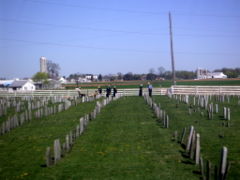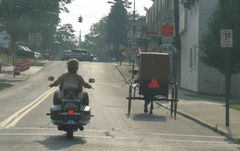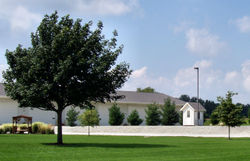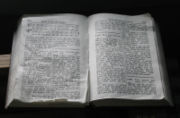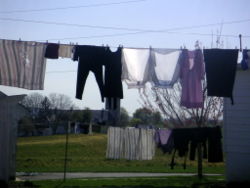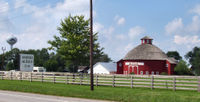Amish
2007 Schools Wikipedia Selection. Related subjects: Peoples
| Amish (Amisch) |
|
|---|---|
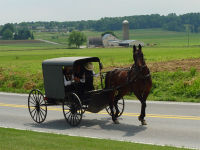 |
|
| Total population | 198,000 (2000 est.) |
| Regions with significant populations | United States, especially Pennsylvania, Ohio, Michigan, Indiana, and Maryland, and Ontario, Canada |
| Language | Pennsylvania Dutch called "Deitsch" by the Amish), English, Alemannic German |
| Religion | Anabaptist Christianity |
| Related ethnic groups | Swiss German; See Pennsylvania Dutch (the Amish are included among the Pennsylvania Dutch) |
The Amish ( IPA: ˈɑːmɪʃ, Pennsylvania Dutch: ˈɑːmɪʃ) are an Anabaptist Christian denomination typically located in the United States and Ontario, Canada, that are known for their restrictions on the use of modern devices such as automobiles and electricity and for their plain dress. The Amish separate themselves from mainstream society for religious reasons: they do not join the military, draw no Social Security, nor do they accept any form of financial assistance from the government, and many avoid insurance. The Amish speak a German dialect known as Pennsylvania Dutch (or Pennsylvania German) at home, and are taught English at school. Church services are conducted mostly in Pennsylvania German. The Amish are divided into separate fellowships, which are each broken down in turn into districts or congregations according to geography. Each district is fully independent and has its own Ordnung, or set of unwritten rules. This article primarily discusses the conservative Old Order Amish fellowships that observe strict regulations on dress, behaviour, and the use of technology. There are many New Order Amish and Beachy Amish groups that use electricity and automobiles, but still consider themselves Amish.
Population and distribution
In 2000, Raber's Almanac estimated there were 198,000 Old Order Amish in the United States. There are Old Order communities in 21 states; Ohio has the largest population (55,000), followed by Pennsylvania (47,000) and Indiana (37,000). The largest Amish settlements are in Holmes County, Ohio; Lancaster County, Pennsylvania and LaGrange, Indiana. Significant populations are also seen in Delaware, Michigan, Iowa (particularly in Kalona and outside Hazleton), Oklahoma (particularly in Chouteau, Mazie & Inola) and Wisconsin. A small population is seen in Vinton County, Ohio; and in a small community nearby Wellston, Ohio called Berlin Crossroads (now Roads). With an average of seven children per family, the Amish population is growing rapidly, and new settlements are constantly being formed to obtain sufficient farmland. Some Beachy Amish have relocated to Central America, including a sizable community near San Ignacio, Belize.
Most Old Order and conservative Amish groups do not proselytize, and conversion to the Amish faith is rare but not unheard of. The Beachy Amish, on the other hand, do pursue missionary work.
Amish as an ethnic group
The Amish are united by a common Swiss-German ancestry, language, and culture, and they marry within the Amish community. The Amish therefore meet the criteria of an ethnic group. However, the Amish themselves generally use the term only to refer to accepted members of their church community, and not as an ethnic designation. Those who do not choose to live an Amish lifestyle and join the church are no longer considered Amish, just as those who live the plain lifestyle but are not baptized into the Amish Church are not Amish. Certain Mennonite churches were formerly Amish congregations. In fact, although more Amish emigrated to America in the 19th century than during the 18th century, most Amish today descend primarily from 18th century immigrants, since the Amish immigrants of the 19th century were more liberal and most of their communities eventually lost their Amish identity.
History
Like the Mennonites, the Amish are descendants of Swiss Anabaptist groups formed in the early 16th century during the radical reformation. The Swiss Anabaptists or " Swiss Brethren" had their origins with Felix Manz (ca. 1498–1527) and Conrad Grebel (ca.1498-1526). The name "Mennonite" was applied later and came from Menno Simons (1496–1561). Simons was a Dutch Roman Catholic priest who converted to Anabaptism in 1536 and was baptized by Obbe Philips after renouncing his Catholic faith and office. He was a leader in the Lowland Anabaptist communities, but his influence reached Switzerland.
The Amish movement takes its name from that of Jacob Amman (c. 1656 – c. 1730), a Swiss Mennonite leader. Amman believed the Mennonites were drifting away from the teachings of Simons and the 1632 Mennonite Dordrecht Confession of Faith, particularly the practice of shunning excluded members (known as the ban or Meidung). However, the Swiss Mennonites (who, because of unwelcoming conditions in Switzerland, were by then scattered throughout Alsace and the Palatinate) never practiced strict shunning as the Lowland Anabaptists did. Amman insisted upon this practice, even to the point of expecting a spouse to refuse to sleep or eat with the banned member until he/she repented of his/her behaviour. This strict literalism brought about a division in the Swiss Mennonite movement in 1693 and led to the establishment of the Amish. Because the Amish are the result of a division with the Mennonites, some consider the Amish a conservative Mennonite group.
The first Amish began migrating to the United States in the 18th century, largely to avoid religious persecution and compulsory military service. The first immigrants went to Berks County, Pennsylvania, but later moved, motivated both by land issues and by security concerns tied to the French and Indian War. Many eventually settled in Lancaster County, Pennsylvania.
Other groups later settled in or spread to Alabama, Illinois, Indiana, Iowa, Kansas, Kentucky, Michigan, Minnesota, Mississippi, Missouri, Nebraska, New York, Ohio, Maryland, Tennessee, Wisconsin, Maine, and Canada. The Amish congregations left in Europe slowly merged with the Mennonites. The last Amish congregation to merge with the Mennonites was Ixheim Amish congregation which merged with the neighboring Mennonite Church in 1937. Some Mennonite congregations, including most in Alsace, are descended directly from former Amish congregations.
No Old Order movement ever developed in Europe and all Old Order communities are in the Americas.
Most Amish communities that were established in North America did not ultimately retain their Amish identity. The original major split that resulted in the loss of identity occurred in the 1860s. During that decade Dienerversammlungen (ministerial conferences) were held in Wayne County, Ohio, concerning how the Amish should deal with the pressures of modern society. The meetings themselves were a progressive idea; that bishops should get together to discuss uniformity was an unprecedented notion in the Amish church. By the first several meetings, the conservative bishops agreed to boycott the Dienerversammlungen. Thus, the more progressive Amish within several decades became Amish Mennonite, and were then later absorbed into the Old Mennonites (not to be confused with Old Order Mennonites). The much smaller faction became the Amish of today. As the non-Amish world's usage of electricity and automobiles increased, a tourist industry sprang up around the Amish in places such as the Pennsylvania Dutch Country.
Religion
Hochmut and Demut
Two key concepts for understanding Amish practices are their revulsion toward Hochmut (pride, arrogance, haughtiness) and the high value they place on Demut or "humility" and Gelassenheit — often translated as "submission" or "letting-be," but perhaps better understood as a reluctance to be forward, self-promoting, or to assert oneself in any way. The willingness to submit to the Will of God, as expressed through group norms, is at odds with the individualism so central to the wider American culture. The Amish anti-individualist orientation is the motive for rejecting labor-saving technologies that might make one less dependent on community; or which, like electricity, might start a competition for status-goods; or which, like photographs, might cultivate individual or family vanity. It is also the proximate cause for rejecting education beyond the eighth grade, especially speculative study that has little practical use for farm life but may awaken personal and materialistic ambitions. The emphasis on competition and the uncritical assumption that self-reliance is a good thing — both cultivated in American high schools and exulted as an American ideal — are in direct opposition to core Amish values.
Separation from the outside and among groups
The Amish often cite three Bible verses that encapsulate their cultural attitudes:
- "Be not yoked with unbelievers. For what do righteousness and wickedness have in common? Or what fellowship can light have with darkness?" ( II Corinthians 6:14)
- "Come out from among them and be ye separate, saith the Lord." (II Corinthians 6:17)
- “And be ye not conformed to this world, but be ye transformed by the renewing of your mind that ye may prove what is that good, and acceptable, and perfect, will of God.” ( Romans 12:2)
The Amish prefer to have minimal contact with non-Amish. However, increased prices for farmland and decreasing revenues for low-tech farming have forced many Amish to work away from the farm, particularly in construction and factory-labor, and, in those areas where there is a significant tourist trade, to engage in crafts for profit. The Amish are ambivalent about both the consequences of this contact and the commoditization of their culture. The decorative arts play little role in authentic Amish life (though the prized Amish quilts are a genuine cultural inheritance, unlike hex signs), and are in fact regarded with suspicion, as a field where egotism and a display of vanity can easily develop.
Amish lifestyles vary between (and sometimes within) communities. These differences range from profound to minuscule. "Black bumper" Beachy Amish drive chromeless automobiles and are rejected as non-Amish by most other groups, while conservative fellowships may disagree over the number of suspenders males should wear (only one is needed, so two could be seen as vanity) or how many pleats there should be in a bonnet. Groups with similar policies are held to be "in fellowship" and consider each other members of the same Christian church. These groups can visit and intermarry with one another, an important consideration for avoiding problems with inbreeding. Thus minor disagreements within communities over dairy equipment or telephones in workshops can create splinter churches and divide multiple communities.
Some of the strictest Old Order Amish groups are the Nebraska Amish, Troyer Amish, the Swartzendruber Amish, and Amish communities in Webster County, Missouri. Nearly all Old Order groups, besides the "Swiss Amish", speak Deitsch in the home, while more progressive Beachy Amish groups often use English in the home. Amish who leave the old ways often remain near their communities, and in general, there are levels of progression from strict Amish to more liberal groups (usually Mennonite).
Baptism, rumspringa, and shunning
The Amish and other Anabaptists do not believe that a child can be meaningfully baptized; this is, in fact, reflected in the name Anabaptist (which means "rebaptizer", as the Anabaptists would baptize adults). Amish children are expected to follow the will of their parents in all issues, but when they come of age, they are expected to make an adult, permanent commitment to the church.
Rumspringa (Deitsch, "running around") is the general term for adolescence and the period leading up to serious courtship during which rules may be relaxed a little. As in non-Amish families, it is understood as a practical matter that there will likely be a certain amount of misbehavior during this period, but it is neither encouraged nor overlooked. At the end of this period, Amish young adults are expected to find a spouse and be baptized. A few choose not to join the church, but to live the rest of their lives in wider society. Some communities will actively shun those who decide to leave the church, even those going to a different Amish congregation with different doctrines. Still other communities practice hardly any shunning, keeping close family and social contact with those who leave the church. Some communities have split in the last century over how they apply the shunning, as in the case of the Holmes County (and area) Amish settlement. Shunning is also sometimes imposed by bishops on church members guilty of offenses such as using forbidden technology. Church members may also be "called to the carpet" to confess before the congregation.
Religious services
The Old Order Amish have worship services every other Sunday at private homes. Since the average district has 168 members, they are often seated in several different rooms, men separate from women. Worship begins with a short sermon by one of several preachers or the bishop of the church district, followed by scripture reading and silent prayer, and another, longer sermon. The service is interspersed with hymns, sung without instrumental accompaniment or harmony. Singing is usually very slow, and a single hymn may take 15 minutes to finish. Worship is followed by lunch and socializing. The service and all hymns are in Deitsch. Amish preachers and deacons are selected by lot (based on Acts 1:23–26) out of a group of men nominated by the congregation. They serve for life and have no formal training. Amish bishops are similarly chosen by lot from those selected as preachers.
Communion
Generally, the Amish hold communion in the spring and the autumn, and not necessarily during regular church services. As with regular services, the men and women are in separate rooms. After receiving the elements, the members each wash and dry one another's feet.
Baptism
The Amish practice of adult baptism is part of the admission into the church. Admission is taken seriously, for to leave the church after joining means being shunned by one's friends and family. On the other hand, those who do not join the Church are not shunned. Those who come to be baptised sit with one hand over their face, to represent their submission and humility to the church. Typically, a Deacon will ladle water from a bucket into the Bishop's hand, and the Bishop will sprinkle the head three times, in the name of Father, Son, and Holy Ghost, after which he blesses each new male member of the church and greets each into the fellowship of the church with a holy kiss. His wife similarly blesses and greets each new female church member.
Weddings
In certain times and places, the father of a husband-high daughter ritually announced that she was available for courtship by painting a door or gate blue, but given the reluctance of many fathers and the eagerness of many teenaged girls, she may have chosen her partner for life long before the paint is applied.
Weddings are typically held on Thursdays in late autumn, after the harvest is in. The bride typically wears blue. It will be a new dress for the wedding, but she will wear it again on other formal occasions, and of course, she wears no makeup. She will have no engagement ring, and no wedding ring will be exchanged, for the Ordnung prohibits personal jewelry. The marriage ceremony itself may take several hours, after which the community celebrates with the newlyweds, sharing food, drink, stories and laughter. Newlyweds typically spend the wedding night in the bride's mother's home.
A sudden abundance of celery crops also hints at a near-and-coming Amish wedding. Celery is a prominent food used in the wedding feast and is also used as decoration throughout the house. Celery is used because of its abundance due to economic dependence on farming. It is not uncommon for the family of the bride to pay for a wedding in stalks and acres of celery.
Funerals
Funeral customs appear to vary more from community to community than other religious services. In Allen County, Indiana, the Amish engage Hockemeyer Funeral Home, the only local funeral director who offers a horse-drawn hearse, to embalm the body. They hold funeral services in the home, however, rather than using the funeral parlor. Instead of referring to the deceased with stories of his life, eulogizing him, services tend to focus on the creation story, and biblical accounts of resurrection. After the funeral, the hearse carries the casket to the cemetery, for a reading from the Bible, perhaps a hymn is read (rather than sung) and the Lord's Prayer. The Amish usually, but not always, choose Amish cemeteries, and purchase gravestones which are uniform, modest, and plain; in recent years, they have been inscribed in English. After a funeral, the community gathers together to share a meal.
Lifestyle and culture
Amish lifestyle is dictated by the Ordnung, which differs slightly from community to community, and, within a community, from district to district. What is acceptable in one community may not be acceptable in another. No summary of Amish lifestyle and culture can be totally adequate because there are few generalities that are true for all Amish. Groups may separate over matters such as the width of a hat-brim, the use of tobacco (permitted among older and more conservative groups), the colour of buggies, or various other issues.
Quilting is perhaps one of the best-known talents of Amish women. Amish quilts are made from scraps of worn clothing and therefore, incorporate those colors. The Pennsylvania Star, Idaho Star, and Shoo-Fly patterns are some of the more popular among their quilts. Most quilts are completely hand-sewn and passed down through each generation. They are often sold at auctions, along with Amish furniture and canned goods.
Modern technology
The Amish, especially those of the Old Order, are probably most known for their avoidance of certain modern technologies. The avoidance of items such as automobiles and electricity is largely misunderstood. The Amish do not view technology as evil. Individuals may petition for acceptance of a particular technology in the local community. In some communities, the church leaders meet annually to review such proposals. In others, it is done whenever necessary. Because the Amish, GAY BELLEND like other Mennonites, and unlike the Catholic or Anglican Churches, do not have a hierarchical governing structure, differing communities often have different ideas as to which technological items are acceptable.
Electricity, for instance, is viewed as a connection to, and reliance on, "the World", the "English", or "Yankees" (the outside world), which is against their doctrine of separation. The use of electricity also could lead to the use of worldly household appliances such as televisions, which would complicate the Amish tradition of a simple life, and introduce individualist competition for worldly goods that would be destructive of community. In certain Amish groups, however, electricity can be used in very specific situations: for example, if electricity can be produced without access to outside power lines. Twelve-volt batteries, with their limited applications, are acceptable to these groups. Electric generators can be used for welding, recharging batteries, and powering milk stirrers. In certain situations, outdoor electrical appliances may be used: lawn mowers (riding and hand-pushed) and string trimmers, for example. Some Amish families have non-electric versions of vital appliances, such as kerosene-powered refrigerators.
Amish communities often adopt compromise solutions involving technology which may seem strange to outsiders. For example, many communities will allow gas-powered farm equipment such as tillers or mowers, but only if they are pushed by a human or pulled by a horse. The reasoning is that Amish farmers will not be tempted to purchase more land to outcompete other farmers in their community if they still have to move the equipment manually. Many Amish communities also accept the use of chemical pesticides and GM crops, forgoing more common Amish organic farming techniques.
The Ordnung is viewed as a guide to community standards, rather than doctrine that defines sin. The four Old Order Amish communities of Allen County, Indiana, are more conservative than most; they use open buggies, even during the winter, and they wear black leather shoes even in the hot summer. The restrictions are not meant to incur suffering. In the 1970s, for example, a farmer near Milan Centre, Indiana, was ordered by his bishop to buy a conventional tractor. He had severe progressive arthritis and, with no sons to harness the horses for him, the tractor was seen as a need, rather than a vanity. The rest of the community continued farming with horses.
The Amish will hire drivers and vans, for example, for visiting family, monthly grocery shopping, commuting to the workplace off the farm, though this too is subject to local regulation and variation. The practice increases the geographic reach of the Amish, and decreases isolation: a horse can travel only about 25 miles and then must rest for a considerable period, restricting the Amish to a radius of 12.5 miles from home. Moreover, a horse and buggy can only sustain 10 MPH over an extended distance and so is impractical for emergencies. Regular bus service between Amish communities has been established in some areas. Hiring a taxi is forbidden on Sundays (as is any transfer of money).
The telephone is another technology whose avoidance is often misunderstood. The Amish dislike the telephone because it interferes with their separation from the world; it brings the outside world into the home; it is an intrusion into the privacy and sanctity of the family and interferes with social community by eliminating face-to-face communication. However, some Amish, such as many of those in Lancaster County, use the telephone primarily for out-going calls, but with the added restriction that the telephone not be inside the home, but rather in a phone "booth" or shanty (actually just a small out-building) placed far enough from the house as to make its use inconvenient. Commonly these private phone shanties are shared by more than one family, fostering a sense of community. This allows the Amish to control their communication and not have telephone calls invade their homes, but also conduct business as needed. In the past, the use of public pay phones in town for such calls was more common; today with dwindling availability of pay phones because of increased cellphone use by the non-Amish population, Amish communities are seeing an increase in the private phone shanties. Many Amish, particularly those who run businesses, utilize voice mail service. The Amish will also use trusted "English" neighbors as contact points for passing on family emergency messages. Some New Order Amish will use cellphones and pagers, but most Old Order Amish will not.
Language
In addition to English, most Amish speak a distinctive High German dialect called Pennsylvania German or Pennsylvania Dutch, which the Amish themselves call Deitsch ("German"). Although now limited primarily to the Amish, Pennsylvania German was originally spoken by many German-American immigrants in Pennsylvania, especially by those who came prior to 1800. The so-called Swiss Amish speak an Alemannic German dialect that they call "Swiss". Beachy Amish, especially those who were born roughly after 1960, and more progressive groups tend to speak predominantly in English at home. There are small dialectal variations between communities, such as Lancaster County and Indiana speech varieties. The Amish themselves are aware of regional variation, and occasionally experience difficulty in understanding speakers from outside their own area.
Deitsch is distinct from Plautdietsch and Hutterite German dialects spoken by other Anabaptist groups.
Dress
Dress code for some groups includes prohibitions against buttons, allowing only hooks and eyes to keep clothing closed; other groups allow members to sew buttons onto clothing. In some groups, certain articles can have buttons and others cannot. The restriction on buttons is attributed in part to their association with military uniforms, and also to their potential for serving as opportunities for vain display. Straight-pins are often used to hold articles of clothing together. In all things, the aesthetic value is "plainness": clothing should not call attention to the wearer by cut, colour or any other feature. Prints such as florals, stripes, polka-dots, etc. are not encouraged in Amish dress, although these trends have been adapted by fellow Mennonites.
Women wear long dresses in a solid, plain colour such as blue. Aprons are often worn, usually in white or black, at home and always worn when attending church. A cape which consists of a triangular shape of cloth is usually worn beginning around the teenage years and pinned into the apron. In the colder months, a wool shroud is sported and pinned to hold together. Heavy bonnets are also worn over the prayer coverings when Amish women are out and about in cold weather.
Men typically wear dark-colored trousers and a dark vest or coat, suspenders, and broad-rimmed straw hats in the warmer months and black felt hats in the colder months. Single Amish men are clean-shaven and married men grow a beard. In some communities, however, a man will grow a beard after he is baptized. Moustaches are generally not allowed, because they are seen as symbols of both pride and the military, a custom with origins in the religious and political persecution in 16th and 17th century Europe. Men of the nobility and upper classes, who often served as military officers, wore mustaches but not beards. The wearing of beards, however, is largely based on the same beliefs against shaving that leads Hasidic Jews and conservative Muslims not to shave their beards.
During summer months, the majority of Amish children, particularly boys go barefoot, including to school. The prevalence of the practice is attested in the Pennsylvania Deitsch saying, "Deel Leit laafe baarfiessich rum un die annre hen ken Schuh." (Some people walk around barefooted, and the rest have no shoes.) The amount of time spent barefoot varies, but many children and a few adults go barefoot whenever Sunday dress is not required.
Health issues
Some Amish are afflicted by heritable genetic disorders, including dwarfism ( Ellis-van Creveld syndrome), and are also distinguished by the highest incidence of twinning in a known human population, various metabolic disorders and unusual distribution of blood-types. Since almost all of the current Amish descend primarily from the same few hundred founders in the 18th century, some genetic disorders from a degree of in-breeding exist in more isolated districts. However, Amish do not represent a single closed community, but rather a collection of different demes or genetically closed communities. Some of these disorders are quite rare, or even unique, and serious enough that they increase the mortality rate among Amish children. The majority of the Amish accept these as "Gottes Wille" (God's will) and reject any use of genetic tests prior to marriage to prevent the appearance of these disorders and also refuse genetic tests to the fetus to discover if it has any genetic disorder.
There is an increasing consciousness among the Amish of the advantages of exogamy. A common bloodline in one community will often be absent in another, and genetic disorders can be avoided by choosing spouses from unrelated communities. For example, the founding families of the Lancaster County Amish are unrelated to the founders of the Perth County Amish community in Canada.
Amish do not carry private commercial health insurance. The Amish of Lancaster County, however, do have their own informal self-insured health plan, called Church Aid, which helps members with catastrophic medical expense. About two-thirds of the Amish there enroll. A handful of American hospitals, starting in the mid 1990s, created special outreach programs to assist the Amish. The first of such programs was instituted at the Susquehanna Health System in central Pennsylvania by James Huebert. The program has earned national media attention in the United States and has spread to several surrounding hospitals. Treating genetic problems is the mission of Dr. Holmes Morton's Clinic for Special Children in Strasburg, Pennsylvania, which has developed effective treatment for such problems as maple syrup urine disease, which previously was fatal. The clinic has been enthusiastically embraced by most Amish and has largely ended a situation in which some parents felt it necessary to leave the community to care properly for their children, which normally might result in being shunned.
A second research and primary care clinic, patterned after Dr. Holmes Morton’s clinic, DDC Clinic for Special Needs Children, is located in Middlefield, Ohio. The DDC Clinic has been treating special needs children with inherited or metabolic disorders since May 2002. The DDC Clinic provides treatment, research and educational services to Amish and non-Amish children and their families. The DDC Clinic is open to all children.
Most Amish do not practice any form of birth control, including the rhythm method.
Education
The Amish do not educate their children past the eighth grade, believing that the basic knowledge offered to that point is sufficient to prepare one for the Amish lifestyle. Almost no Amish go to high school, much less to college. In many communities, the Amish operate their own schools, typically one-room schoolhouses with teachers from the Amish community. These schools provide education in many crafts, and therefore is eligible as a vocational education and fulfills the nationwide requirement of education through 10th grade or the equivalent. There are Amish children that go to non-Amish public schools, even ones that are far away and include a very small Amish population. For instance, there have been some Amish children who have attended Leesburg Elementary School in Leesburg, Indiana (about 12 miles from Nappanee, Indiana) because their families lived on the edge of the school district. In the past, there have been major conflicts between the Amish and outsiders over these matters of local schooling. But for the most part they have been resolved and the educational authorities allow the Amish to educate their children in their own ways. Sometimes there are conflicts between the state-mandated minimum age for discontinuing schooling and the younger age of children who have completed eighth grade. This is often handled by having the children repeat eighth grade until they are old enough to leave school. However, in the past, when comparing standardized test scores of Amish students, the Amish have performed above the national average for rural public school pupils in spelling, usage of words and in arithmetic. They performed below the national average, however, in vocabulary .
On May 19, 1972, Jonas Yoder and Wallace Miller of the Old Order Amish and Adin Yutzy of the Conservative Amish Mennonite Church were each fined $5 for refusing to send their children, aged 14 and 15, to high school. In Wisconsin v. Yoder, the Wisconsin Supreme Court overturned the conviction and the U.S. Supreme Court affirmed, finding that the benefits of universal education do not justify violation of the Free Exercise Clause of the First Amendment.
The decision of the U.S. Supreme Court quoted sociology professor John A. Hostetler (1918–2001), who was born into an Amish family, wrote several books about the Amish, Hutterites, and Old Order Mennonites, and was then considered the foremost academic authority on the Amish. Donald Kraybill, Distinguished College Professor and Senior Fellow in the Young Centre for Anabaptist and Pietist Studies at Elizabethtown College, is likely the most important scholar studying the Amish today.
Relations with the outside world
The Amish as a whole feel the pressures of the modern world. Child labor laws, for example, are seriously threatening their long-established ways of life. Amish children are taught at an early age to work hard. Amish parents will supervise the children in new tasks to ensure that they learn to do them effectively and safely. The modern child labor laws conflict with allowing the Amish parents to decide whether or not their children are competent in hazardous tasks.
Contrary to popular belief, some of the Amish vote, and they have been courted by national parties as potentially crucial swing-constituencies: their pacifism and social conscience cause some of them to be drawn to left-of-center politics, while their generally conservative outlook causes others to favour the right wing. They are nonresistant and rarely defend themselves physically or even in court; in wartime, they take conscientious objector status; their own folk-history contains tales of heroic nonresistance.
Like many Mennonites, Amish rely on their church and community for support, and thus reject the concept of insurance. An example of such support is barn raising, in which the entire community gathers together to build a barn in a single day.
In 1961, the United States Internal Revenue Service announced that since the Amish refuse United States Social Security benefits and have a religious objection to insurance, they need not pay these taxes. In 1965, this policy was codified into law. Self-employed individuals in certain sects do not pay into, nor receive benefits from, United States Social Security, nor do their similarly-exempt employees. Amish employees of non-exempt employers are taxed, but they do not apply for benefits. A provision of this law mandates that the sect provide for their elderly and disabled; one visible sign of the care Amish provide for the elderly are the smaller Grossdaadi Heiser or Daadiheiser ("grandfather house") often built near the main dwelling. The Amish are not the only ones exempt from Social Security in the United States. Ministers, certain church employees and Christian Science practitioners may qualify for exemption under a similar clause. Otherwise, the Amish pay the same taxes as other American citizens.
The Amish have, on occasion, encountered discrimination and hostility from their neighbors. During the World Wars, Amish nonresistance sparked many incidents of harassment, and young Amish men forcibly inducted into the services in violation of the Thirteenth Amendment to the U.S. Constitution were subjected to various forms of ill-treatment. In the present day, anti-Amish sentiment has taken the form of systematic harassment, particularly claiping, the act of pelting the horse-drawn carriages used by the Amish with stones or similar objects as the carriages pass along a road, most commonly at night. A 1988, made-for-TV film, A Stoning In Fulham County, is based on a true story involving one such incident, in which a six-month-old Amish infant girl was struck in the head by a rock and died from her injuries. In 1997, Mary Kuepfer, a young Amish woman in Milverton, Ontario, Canada, was struck in the face by a beer bottle believed to have been thrown from a passing car ; she required thousands of dollars' worth of surgery to her face (which was paid for by an outpouring of donations from the public). It was later believed that this was not a case of claiping; the bottle may have been thrown by another group of Amish youth in a passing buggy.
The Amish portrayed in popular entertainment
Movies: Peter Weir's 1985 acclaimed drama Witness is set and filmed in the Amish community of Lancaster County, Pennsylvania. The story focuses on the interaction and culture clash of an Amish family with a Philadelphia detective hiding among them while he investigates a murder that an Amish boy witnessed. The film won an Oscar for screenwriting and was nominated for several other Academy Awards. Harvest of Fire is a 1996 Hallmark Hall of Fame made-for-tv movie about an FBI agent's investigation of cases of suspected arson in an Amish farming community, and the relationship she develops with an Amish woman who helps her to uncover the truth. The 2002 documentary Devil's Playground follows a group of Amish teenagers during rumspringa and portrays their personal dilemma with both the vanities of the English world and the decision of whether or not to be baptised as adult members of the church.
Some comic movie portrayals of the Amish include Randy Quaid’s Amish character "Ishmael Boorg" in Kingpin directed by the Farrelly brothers in 1996 and the 1997 For Richer or Poorer, starring Tim Allen and Kirstie Alley, also about city folk hiding among the Amish. Rob Reiner's 1994 comedy, North, includes a short vignette sequel to Witness with two of the original actors, Kelly McGillis and Alexander Godunov, portraying what might have happened to their characters after the end of Witness. The 1968 comedy The Night They Raided Minsky's is the story of an Amish girl who goes to New York in the 1920s to be a dancer and ends up as a burlesque stripper.
Novels: Amish farmers involved in murder mysteries are also central to Paul Levinson's 1999 Locus Award-winning novel The Silk Code, a science fiction mystery about bio-technology and mysterious deaths and Jodi Picoult's 2003 novel (and 2004 tv movie) Plain Truth, a crime drama about the death of a newborn infant on an Amish farm. The Amish are portrayed in other novels including Lurlene McDaniel's 2002 The Angels Trilogy, and Beverly Lewis' extensive series of Amish romantic fiction.
Theatre: An early portrayal of the Amish, the 1955 Broadway musical show Plain and Fancy, is also set in Lancaster County but with a much lighter tone: it tells the story of a couple from New York who encounter the quaint Amish lifestyle when they arrive to sell off some property. This show brought depictions of shunning and barn-raising to the mainstream American audience for the first time.
Television: In 1988 NBC aired a family drama called Aaron's Way about an Amish family who move to California and have to adjust to a non-Amish lifestyle; numerous tv shows have had individual episodes with Amish characters and storylines, including Picket Fences, Murder She Wrote, MacGyver, among others. . In the summer of 2004 a controversial reality-television program called Amish in the City was aired on UPN, where Amish teenagers are exposed to non-Amish culture while living together with "English" teens as the Amish teens decide if they want to be baptized into their church.
Music: "Weird Al" Yankovic's 1996 parody Amish Paradise song and accompanying video was a send-up of Coolio's earlier hip-hop Gangsta's Paradise, with Yankovic in Amish garb and lyrics reflecting Amish themes.
Other: The original Extreme Championship Wrestling featured a wrestler, Roadkill, who dressed in Amish clothing and was billed as being from Lancaster County.
Groups sometimes confused with the Amish
As Anabaptist religious groups that avoid automobiles and live apart from the outside world, Old Order Mennonites, Hutterites, and Old German Baptist Brethren are sometimes considered the same as the Old Order Amish by outsiders. However, all were distinct groups before emigrating from Europe, with different dialects and separate cultural and religious traditions. The Amish are called after Jakob Ammann, who disagreed with his Mennonite (after Menno Simons) brethren. The Hutterians, who live communally, come from the same broad Anabaptist background but were never Mennonites. They use the most modern farming methods on their colonies' farms. They do not use sedans, only extended- and crew-cab pickup trucks, for personal transportation.
Quakers are unrelated to the Amish, although the early Quakers were influenced to some degree by the Anabaptists and were also " plain people" in manner and lifestyle. Modern Quakers have since abandoned their traditional dress.
Despite the vast differences between them, the Amish are sometimes confused with Mormons, another distinctly different religious group. The French version of the film Witness mistranslated "Amish" as "Mormon".
Oftentimes, members of the Haredi Jewish religious movement Hasidism are confused with the Amish or other Anabaptist groups that separate themselves from mainstream modern society. This was used to comic effect by Gene Wilder in the film ' The Frisco Kid'. The Haredi belief in limited contact with the secular world and modest behaviour and dress, similar to the styles of pre-20th century Eastern Europe, can erroneously lead some to believe that Hasidim avoid all modern technology and therefore must be Amish.
Abuse controversy
Several recent high-profile cases have brought attention to sexual abuse of children among the Amish in some of the smaller more isolated communities, which has been called, perhaps erroneously, "almost a plague in some communities." Bishops and preachers of Old Order groups settle conflicts and mete out punishment for sins (generally in the form of shunning), and sexual abuse may therefore be less often reported to law enforcement. Those who are mistreated have little recourse and may be shunned for seeking outside help. Mary Byler was raped over a hundred times between the ages of 8 and 14 by her brothers; she was excommunicated and shunned for reporting her abusers. David Yoder, who grew up in a conservative Swartzentruber Amish family, recalls one man who committed incest with his daughter and was punished with 90 days of shunning. Another young woman was repeatedly raped by her brother-in-law, who was eventually punished by being shunned for two and a half months. Some groups have also been accused of tolerating severe physical abuse of children. Although the rate of physical or sexual abuse does not appear to be higher in the Amish community than in the general public, their physical and social isolation from the outside world makes it difficult for victims to seek help.
The Lancaster Pennsylvania based Lancaster Intelligencer Journal published a 10-part series on domestic abuse, child abuse and child sexual abuse inside Amish (and Mennonite) families from the heart of PA Dutch country. These articles show how such abuse is systematically silenced inside Amish (and Mennonite) churches. The series published on August 4, 2004, won a state-wide award for Best Public Service reporting in Pennsylvania. It began with an article entitled Silenced by Shame: Hidden in Plain Sight and ended with an article entitled The Ties That Bind Can Form the Noose. As one article: Beliefs, Culture Can Perpetuate Abuse in Families, Churches makes clear, child and spousal abuse is often concealed and denied in the service of other church ends.

